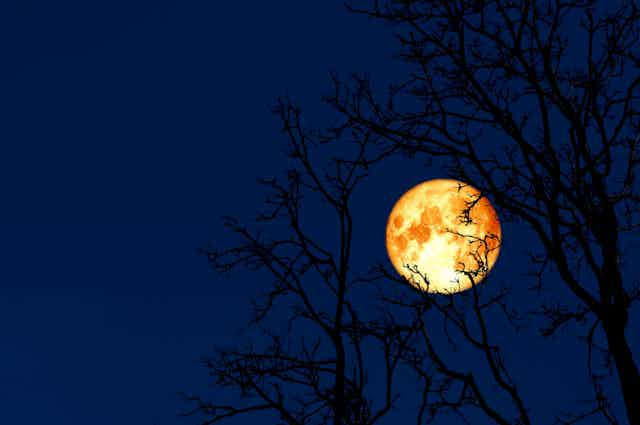The worm moon has risen. The final full moon of winter in the northern hemisphere appeared on March 25 and owes its name to Native Americans who noted winter’s end by the trails of earthworms it illuminated on the newly thawed soil.
Common names of full moons generally come from seasonal animals, colours or crops: wolf moon, pink moon, harvest moon. But the worm moon may be losing its significance, as climate change leads to wetter summers and milder winters in much of the world. I’ve been an earthworm scientist for more than three decades, and, of late, I’m seeing signs of worms at the surface in months when they used to be inactive.
To track how the worm moon might be changing we can look at a particular earthworm species (Lumbricus terrestris, aka the dew worm, nightcrawler or lob worm) which is unusually easy to track. Also sometimes called the common earthworm, if you see a big worm in the garden, it’s likely to be this species.

Do the seasons feel increasingly weird to you? You’re not alone. Climate change is distorting nature’s calendar, causing plants to flower early and animals to emerge at the wrong time.
This article is part of a series, Wild Seasons, on how the seasons are changing – and what they may eventually look like.
Most worms spend most of their lives underground, but the dew worm almost completely leaves its deep burrow, with tail tip left in, as it ventures on to the soil surface every night to feed on dead leaves. These worms also mate on the soil surface. They may be hermaphrodite (both male and female) but still need to exchange sperm with a partner – each fertilising the other.
Such activities usually take place under the cover of darkness to avoid birds and other potential daytime predators. However, the worms are restricted by soil conditions at the top of the burrow. They cannot surface if the soil is baked dry (in summer) or frozen (in winter).

In theory, the passing of winter would kickstart the surface activity (and therefore the worm moon). Yet if the winter isn’t that cold, we perhaps need to reconsider which moon should be termed the “worm moon”. Maybe a date earlier in the year would be better, or perhaps the term may cease to have any real meaning.
We can get a sense of how these earthworms can adapt to changing circumstances by looking at the northernmost populations, such as those in Finland, which are exposed to 24 hours of daylight in summer. These “white nights”, when the sky never gets dark, put additional stress on these worms as they cannot use darkness to hide from predators but must still feed and mate at the surface while conditions allow.
Finland v Lancashire v Ohio
A decade ago, colleagues and I set out to see if Finnish worms behaved any differently during the white night period to worms of the same species taken to Finland from lower latitudes. We compared native dew worms from an area in south-west Finland at 60°N, with those from Lancashire in the UK (53°N) and Ohio in the US (40°N, more than 2,000km south of Finland), both of which have dark nights throughout the year.
We put these worms outdoors under ambient (white night) light in soil-filled drainpipes (1m deep) in a large, controlled temperature water bath (an old chest freezer with no lid). We looked at their feeding and mating, and, in parallel, repeated the experiment under darkened conditions at “night”.
In darkness, worms from all three origins were similarly very active in feeding and mating.
Under ambient conditions, the Finnish worms were generally the most active. They emerged earlier in the evening and ceased their activity later in the morning than those from the two more southerly populations. It seems the species had adapted to its conditions, with a normal reluctance to surface during daylight overtaken by a need to feed and mate.
Perhaps with warming soils, earthworms are becoming more active during traditionally colder or drier months. This will increase their effect on the soil – earthworms are ecosystem engineers and generally lead to increased soil fertility – which is generally positive, even if churning up the soil can lead to further decomposition and greenhouse gas emissions.
A worm moon and white nights would never normally appear in the same sentence. However, changes in the activities of worms as the global climate becomes less predictable means we may need to rethink at least one of our terms of reference that has marked time for hundreds or thousands of years. Enjoy the traditional worm moon while it lasts.

